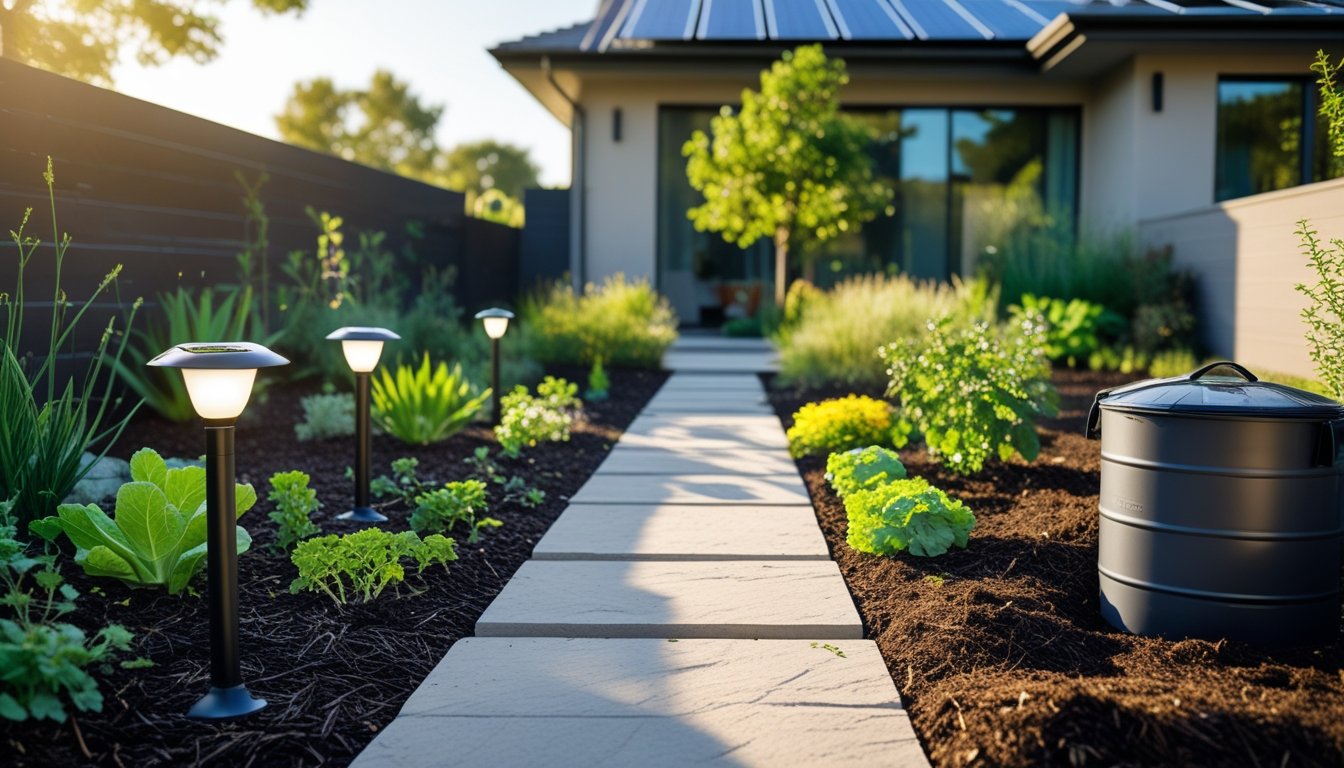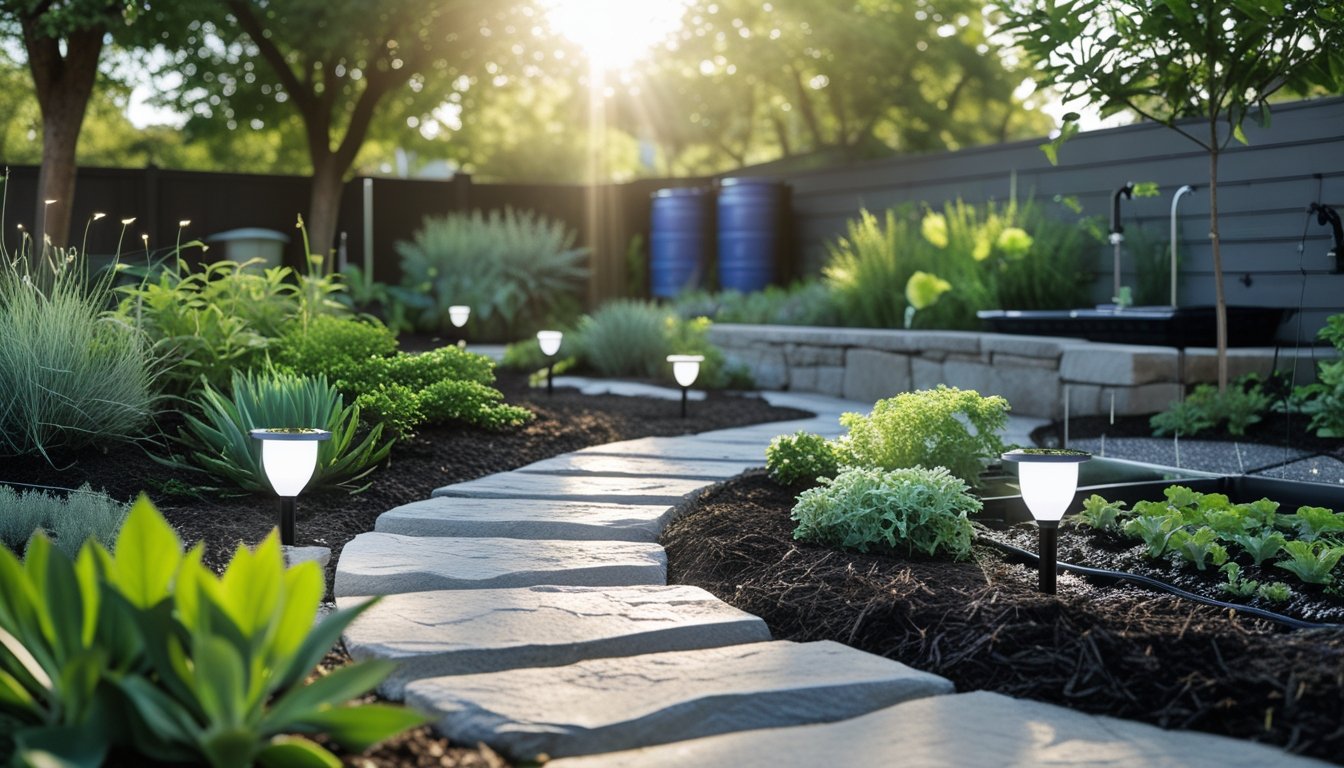Late updated: 07 Aug 2025 13:08
Written by: Daniel Harper
Innovative Energy-Saving Landscaping Tips: Transform Your Garden Efficiently
In an era where energy conservation is of paramount importance, integrating innovative energy-saving techniques into our landscaping practices offers a practical solution. By strategically using shade trees and designing landscapes that require less water, we can significantly reduce both our environmental impact and utility bills. Our outdoor spaces can become more than just areas of aesthetic appeal; they can actively contribute to a sustainable lifestyle.

Many of us are eager to find effective ways to conserve resources while maintaining beautiful gardens. Incorporating elements like windbreaks, native plants, and creative irrigation systems not only enhances the natural beauty of our homes but also boosts energy efficiency. These techniques allow us to focus on conservation without sacrificing style.
As we explore a variety of creative landscaping ideas, from innovative ground covers to energy-conscious water features, we realise the potential of turning our gardens into eco-friendly havens. Our journey through these topics will provide actionable strategies to help maximise our energy savings while nurturing our environment.
Key Takeaways
- Energy-saving landscaping reduces utility costs.
- Innovative methods maximise resource conservation.
- Eco-friendly landscapes enhance home appeal.
Fundamental Energy-Saving Landscaping Strategies
In our efforts to improve energy efficiency through landscaping, we focus on strategies that leverage smart plant choices, effective windbreaks, summer shading, and the creation of microclimates. These approaches help to lower energy bills and enhance the sustainability of our outdoor spaces.
Smart Plant Selection and Placement
Selecting the right plants is foundational to energy-efficient landscaping. By choosing deciduous trees, we benefit from their seasonal foliage. They provide shade during the summer, reducing cooling costs, and allow sunlight through in the winter to warm our homes.
Evergreen trees and shrubs serve another purpose, as they provide year-round wind and noise barriers. Positioning these plants strategically around our properties can significantly enhance energy efficiency.
Highlighting local and native plant species ensures better growth and less maintenance. These plants are adapted to the local climate and typically require less water and fertilisation, further reducing our environmental impact. By integrating these concepts, our landscaping efforts not only look aesthetically pleasing but also drive energy savings.
Creating Effective Windbreaks
Windbreaks are essential for reducing wind speed and shielding our homes from harsh conditions. Properly placed windbreaks, primarily using evergreen trees and dense shrubs, can cut wind velocity by up to 50%, offering significant reductions in heating costs.
To build a windbreak, we typically arrange several rows of trees and shrubs at varying heights. A mix of taller trees at the back and shorter foliage at the front enhances the barrier effect.
The distance of the windbreak from our property is crucial. An optimal placement is usually within 30 meters of the building. This distance maximises protection without overcrowding or causing resource competition among plants. With these formations, energy efficiency is no longer just an indoor effort.
Utilising Shade for Summer Energy Savings
Summer heat can ramp up energy bills, especially cooling costs. Shade trees become invaluable here, particularly those with broad leaves. By shading windows and roofs, these trees naturally cool our homes.
In addition to large trees, we can utilise structures like pergolas covered with vines to create shaded garden areas. These additions not only reduce direct sunlight but also add aesthetic value to our landscapes.
The orientation matters. Planting shade trees on the east and west sides of our homes is most effective. These positions block the intense morning and afternoon sun. With these considerations in mind, we can leverage shade efficiently to maintain cooler indoor environments during summer months.
Harnessing Microclimates for Efficiency
Microclimates are small, distinct climate zones within our landscapes that offer unique growing conditions. By using landscape features like water bodies, ground covers, and vegetation, we craft specialised areas that influence temperature and humidity.
Trees and shrubs affect these zones through evapotranspiration, cooling the air and lowering ambient temperatures. This process is crucial in moderating close-to-home climates, contributing to energy savings by reducing dependency on artificial heating and cooling.
In energy-efficient landscaping, recognising and utilising microclimates provide us with an advanced tool. Tailoring plant selection and placement to suit these microclimates optimises growth conditions and energy conservation efforts. This strategy expands the potential of our landscapes to function as sustainable energy savers.
Innovative Water and Resource Conservation Methods

Innovative water and resource conservation methods in landscaping are essential to sustainability. Key strategies include choosing drought-tolerant plants, using smart irrigation systems, applying mulch, and incorporating rain gardens and rain barrels. These techniques ensure efficient water use and maintain a beautiful landscape with minimal environmental impact.
Drought-Tolerant and Native Plant Choices
Selecting drought-tolerant and native plants is a savvy approach in water-efficient landscaping. These plants, accustomed to local climate conditions, require less water and maintenance. We can integrate species such as lavender, succulents, and native grasses. This method, known as xeriscaping, reduces the environmental footprint of our landscape while fostering biodiversity. Using native plants also supports local wildlife and keeps them in harmony with the environment.
Smart Irrigation Systems and Drip Irrigation
Employing smart irrigation systems and drip irrigation revolutionises our water conservation strategies. Smart systems adjust watering schedules based on weather forecasts, soil moisture, and plant needs, ensuring efficient water usage. Drip irrigation systems target the base of plants directly, minimising evaporation and runoff. By administering precise amounts of water directly to roots, these systems optimise consumption and reduce waste, promoting healthier plant growth.
Mulch Application for Moisture Retention
Applying mulch is an effective technique to retain soil moisture and suppress weed growth. Mulch acts as an insulating layer, keeping the soil cool and reducing water evaporation. By using organic materials like wood chips, bark, or straw, we enrich the soil as the mulch breaks down. This practice not only conserves water but also improves soil health and nutrient availability, enhancing overall landscape vitality.
Incorporating Rain Gardens and Rain Barrels
Incorporating rain gardens and rain barrels into our landscapes captures and uses rainwater efficiently. Rain gardens are designed to absorb and filter rainwater runoff, allowing us to manage stormwater sustainably while creating attractive garden spaces. Rain barrels collect and store water from rooftops, offering a valuable resource for irrigation during drier periods. Together, these methods reduce reliance on municipal water supplies and lower water bills.
Frequently Asked Questions

Exploring energy-saving landscaping involves understanding strategic planting for shading, water-efficient techniques, and the integration of native plants. These methods not only conserve energy but also help in reducing utility costs.
What are the best practices for landscaping to maximise energy efficiency?
Maximising energy efficiency through landscaping involves selecting the right plant types and positioning them strategically. Trees and shrubs should be placed to provide shade and act as windbreaks. Utilising mulches and ground covers can also retain soil moisture, reducing the need for frequent watering.
How do strategic planting choices contribute to energy conservation?
Strategically planting shade trees and shrubs can significantly reduce heating and cooling expenses. By creating shaded areas and wind barriers, we can decrease the reliance on HVAC systems. This thoughtful placement not only cools the environment naturally but also improves the aesthetic appeal of the landscape.
Could you explain the link between water-efficient landscaping and reduced energy consumption?
Water-efficient landscaping, such as xeriscaping, requires less irrigation, which indirectly saves energy used for water pumping and treatment. Efficient irrigation systems and the use of drought-tolerant plants also help in reducing energy consumption related to water supply.
What are some cost-effective landscaping techniques to aid in energy saving?
Implementing cost-effective techniques like using recycled materials for mulch and incorporating ground covers can drastically cut expenses. Low-cost planting options, such as native grasses, are not just economical but also reduce the need for extensive maintenance, further conserving energy.
In what ways can landscape design reduce the energy demands of heating and cooling systems?
Landscape design plays a crucial role in managing the microclimate around a home. By positioning deciduous trees on the south and west of a property, we can enhance shade in summer and allow sunlight in winter, effectively reducing the dependence on heating and cooling systems.
How can the use of native plants in landscaping lead to reductions in energy use?
Using native plants in landscaping significantly limits the necessity for watering, fertilising, and pest control, as these plants are naturally adapted to the local climate. Their resilience reduces maintenance requirements, leading to reduced energy expenditure associated with gardening equipment and irrigation.
